Some of the first signs of spring are the colorful blossoms of tulips and daffodils. Without fail, those early pops of springtime color bring delight to our souls. As the tulips and daffodils bravely poke their leaves up through the soil, send out stems and buds, and then finally bloom, they remind us that winter will not last forever. And while they’re beautiful to admire and look at, they’re also a fun and hands-on way for kids to get outside learn about nature! Today, Leslie Alvis, Ohio homeschooling mom of four is going to show you how to dissect some of these beautiful spring flowers and examine them more closely with your children. She’s also got a couple of bonus activities to do with your tulips and daffodils, so be sure to read through the whole post!

Children learn by touching
I loved daffodils and tulips long before I had children. But their wonder and delight grew when I began to experience them with my kids. To a small child, whose outdoor world has been governed by cold and snow for so many months, daffodils and tulips bring sheer amazement. They’re so cheerful, so undaunted by the often frigid world around them.
Children learn so much by touching and feeling the natural world around them. Dissecting tulips and daffodils is particularly delightful because it allows kids to take apart and touch each part of the flowers. Other than common weeds like dandelions, I don’t usually let my kids tear flowers apart! So, this activity definitely felt special to them. It reminded me that the simple beauty of nature brings so much wonder and delight to a child. Learning experiences don’t have to be complicated. They can simply involve removing the delicate pieces of a flower and learning what those pieces are called.
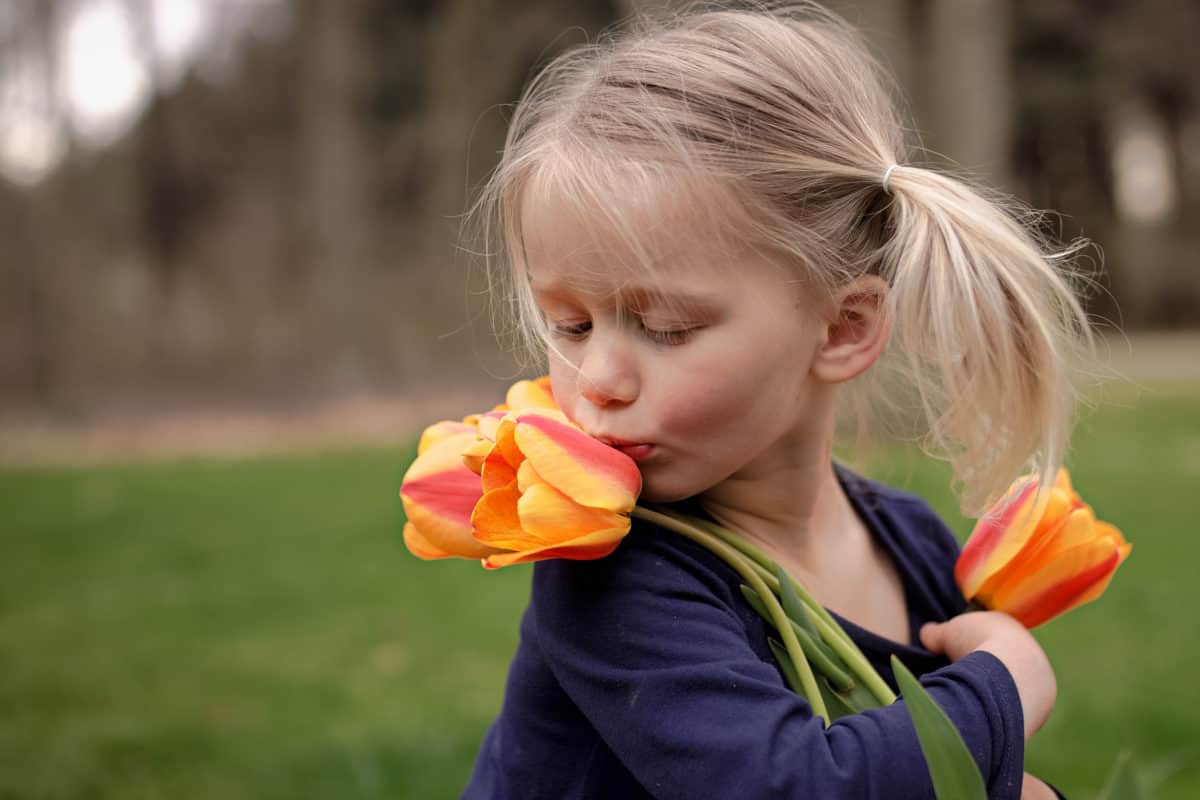
Picking daffodils and tulips
If you choose to do a flower dissection, be sure your child has permission to pick the flowers. Asking before picking flowers has been a hard lesson for each of my children to learn. It usually comes up most during their preschool years. They’re just so overcome by the beauty of the flower, they find picking it irresistible!
Tulips, in particular, seem to just call them. This has always been a big deal because tulips are often a little sparse in our flowerbeds. Yet, at some point in their early years, every one of my children has systematically picked the handful we had. One of my offspring once even picked and dissected the only bud we had, just to see what it looked like inside. Childhood curiosity! This dissection activity satisfies that curiosity. It also deepens kids’ understanding and appreciation of daffodils and tulips.
This is also a great time to teach them that just because it’s okay to pick some flowers doesn’t mean it’s okay to pick all flowers! I try to remind my children of the old adage, “What if everybody did?” If everyone picked every daffodil or tulip they saw, there wouldn’t be any left for us to enjoy in nature.
If you don’t have permission to pick flowers (or don’t have access to flowers), you can usually find cut flowers to purchase at a grocery or flower store.
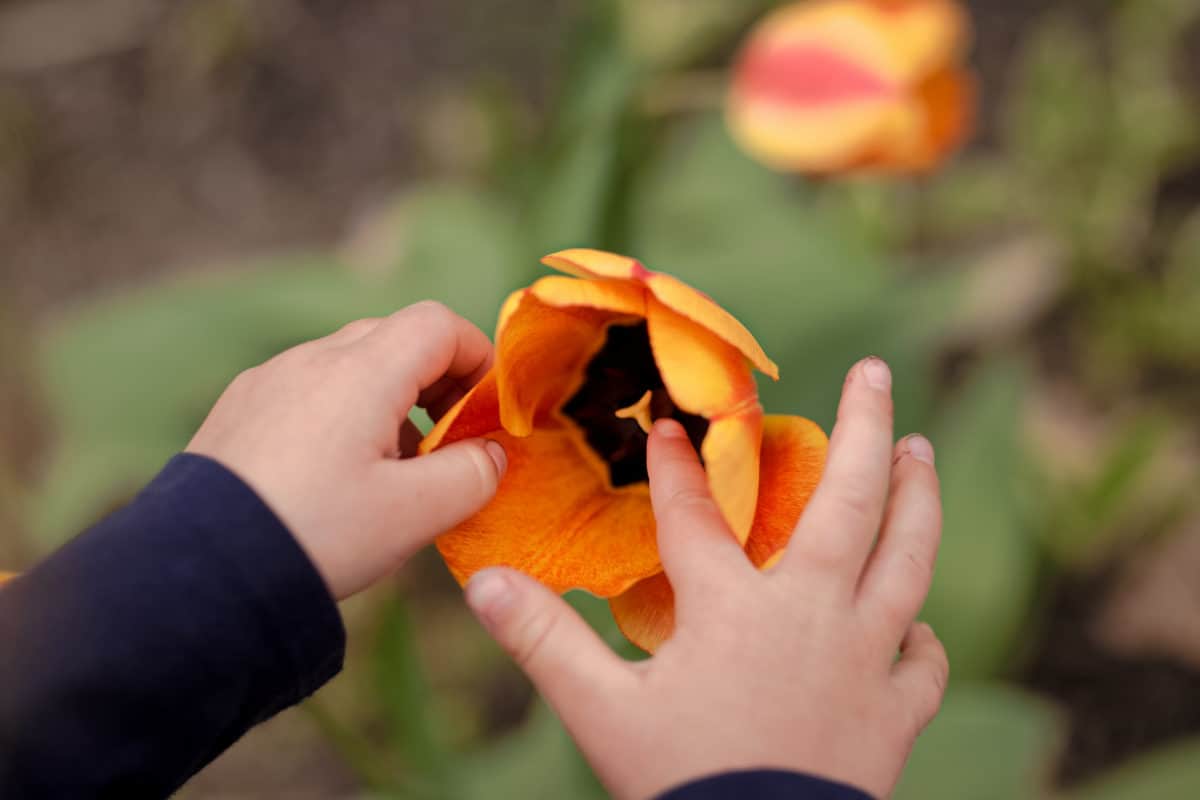
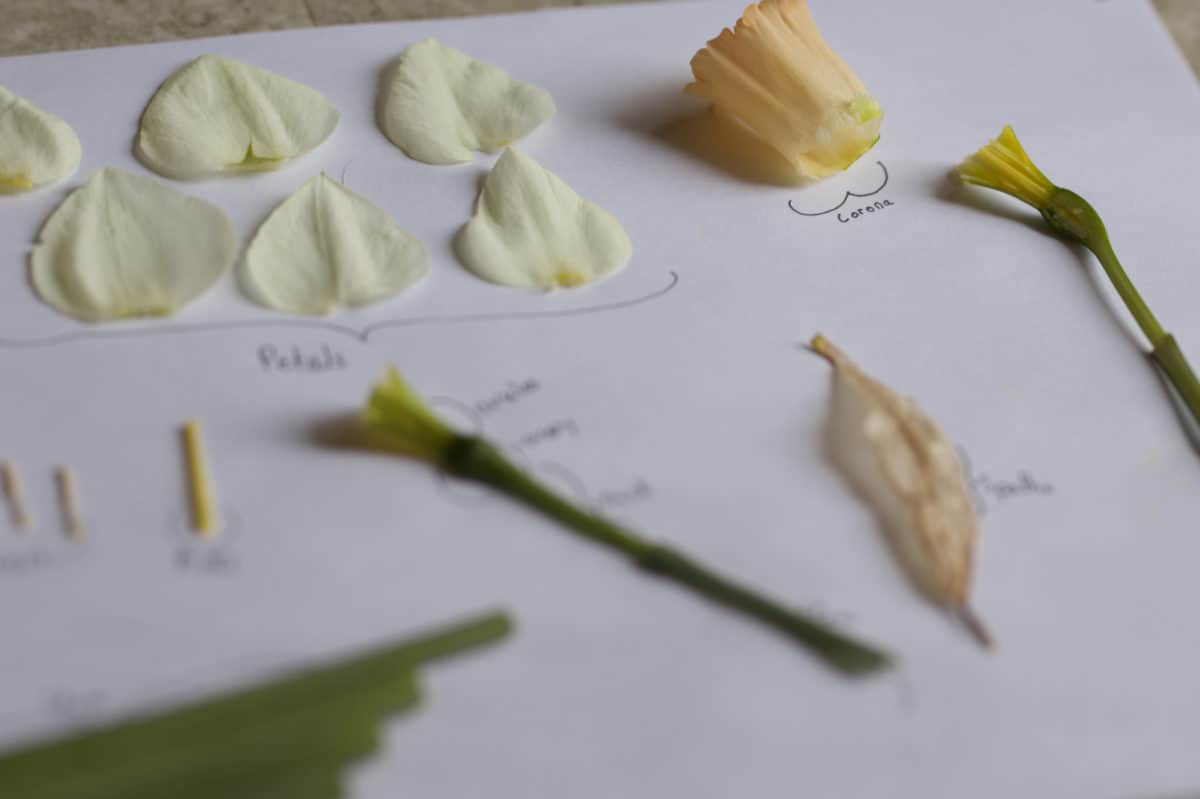
Daffodil and tulip dissection with kids
Daffodil or tulip dissection is one of the easiest and simplest nature experiments you can do with your kids! All you need is a couple flowers and a sheet of paper. You can also use this printable if you’d rather not make your own. We enjoyed laying out our own pages and labeling them ourselves. If you have a magnifying glass, be sure to keep that handy so your kids can examine each part more closely!
For our daffodil and tulip dissection, we simply separated the pieces of each flower and arranged them on a piece of paper. You can also cut the flower in half with a sharp knife, but my kids voted for taking it apart by hand. That way even the little one could participate.
My oldest daughter copied a chart showing the parts of the flowers, then the younger girls got to arrange their own flower pieces. This simple activity was so much fun! They all learned so much about the details of the flowers. It felt like playing, taking apart the petals and stems and other parts of the blossoms. After dissecting a daffodil, the girls couldn’t wait to try a tulip.
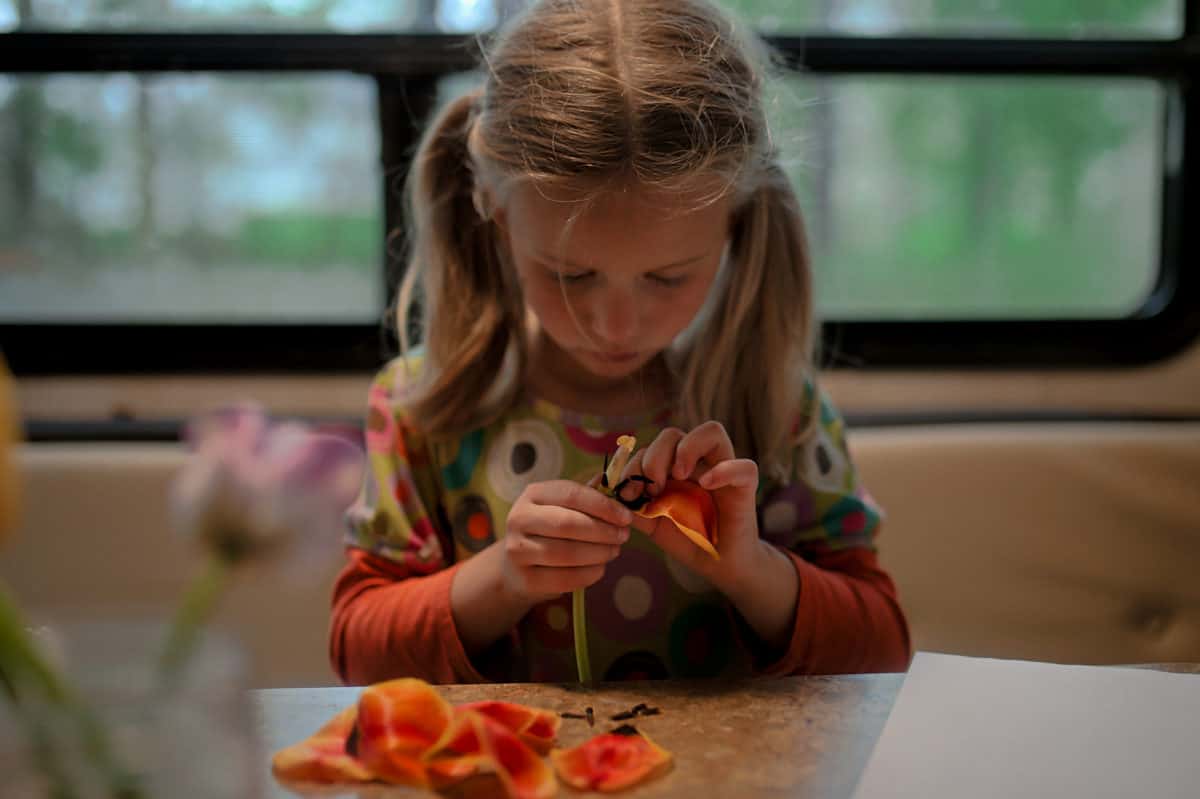
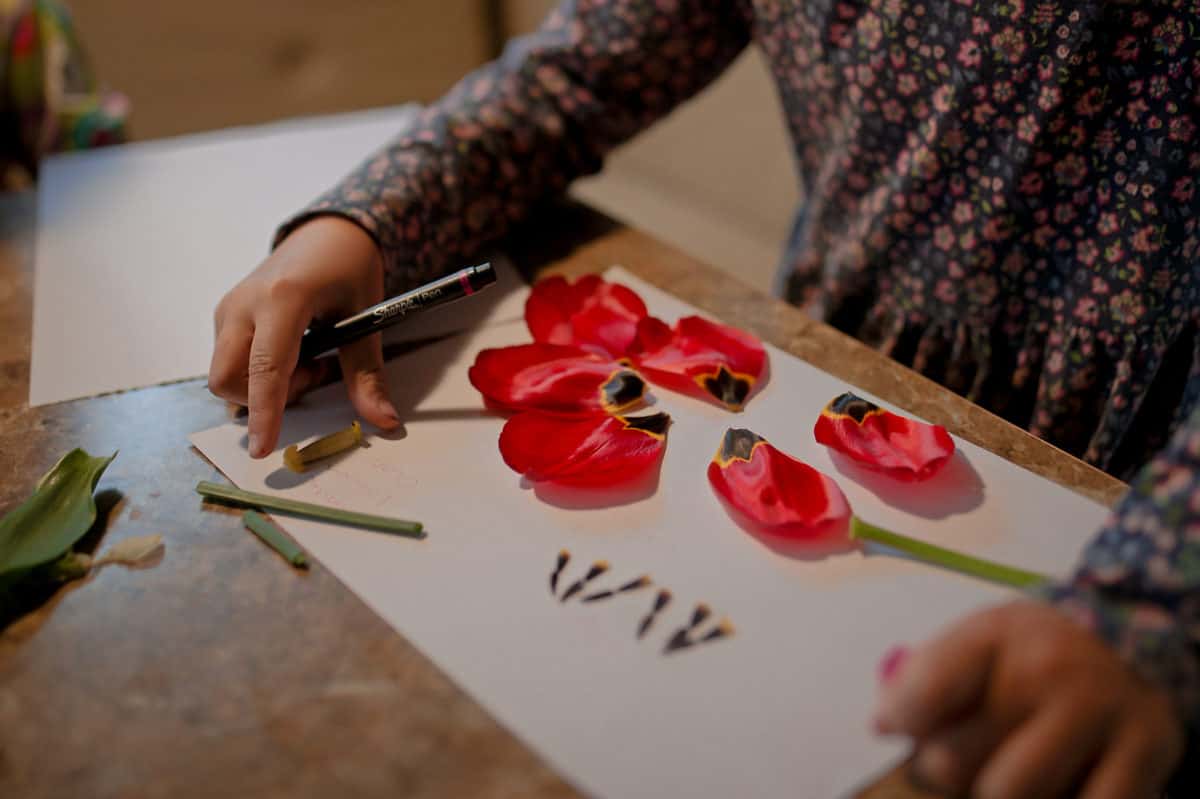
Identifying parts of a daffodil or tulip
For younger children, a simple breakdown of stem, leaves, and petals may be a deep enough look into the parts of the daffodils and tulips. For older kids, we’re also including a more in-depth at the parts of these flowers and their functions. If you’re looking for a little more information about the parts of a daffodil, check out this page.
- Stem: The stem is the tall, green stalk that carries water and nutrients from the earth up to the flower.
- Leaves: This is where photosynthesis happens—where the plant takes the sun’s energy and turns it into food for the plant!
- Spathe: The papery brown sheath that covered the bud before it opened.
- Ovary: Filled with ovules, or eggs, which later become seeds after the flower has been pollinated by bees or other insects.
- Pistil: This is the center part of the flower, including the style and the stigma at the top.
- Stamen: The six little stalks surrounding the pistil. The stalk part is called the filament and the pollen-covered tip is the anther.
- Petals: This is most visible and colorful part of the flower.
- Corona: The inside layer of petals on the daffodil, also called the crown or trumpet
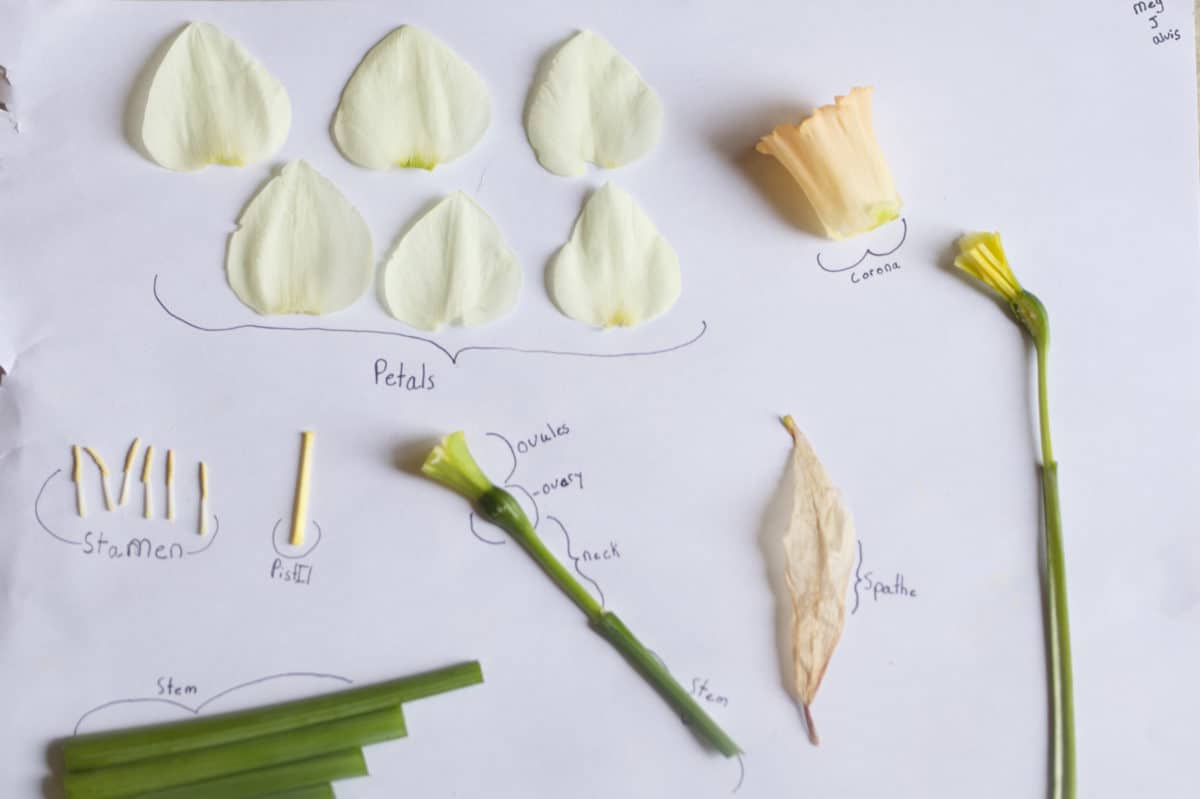
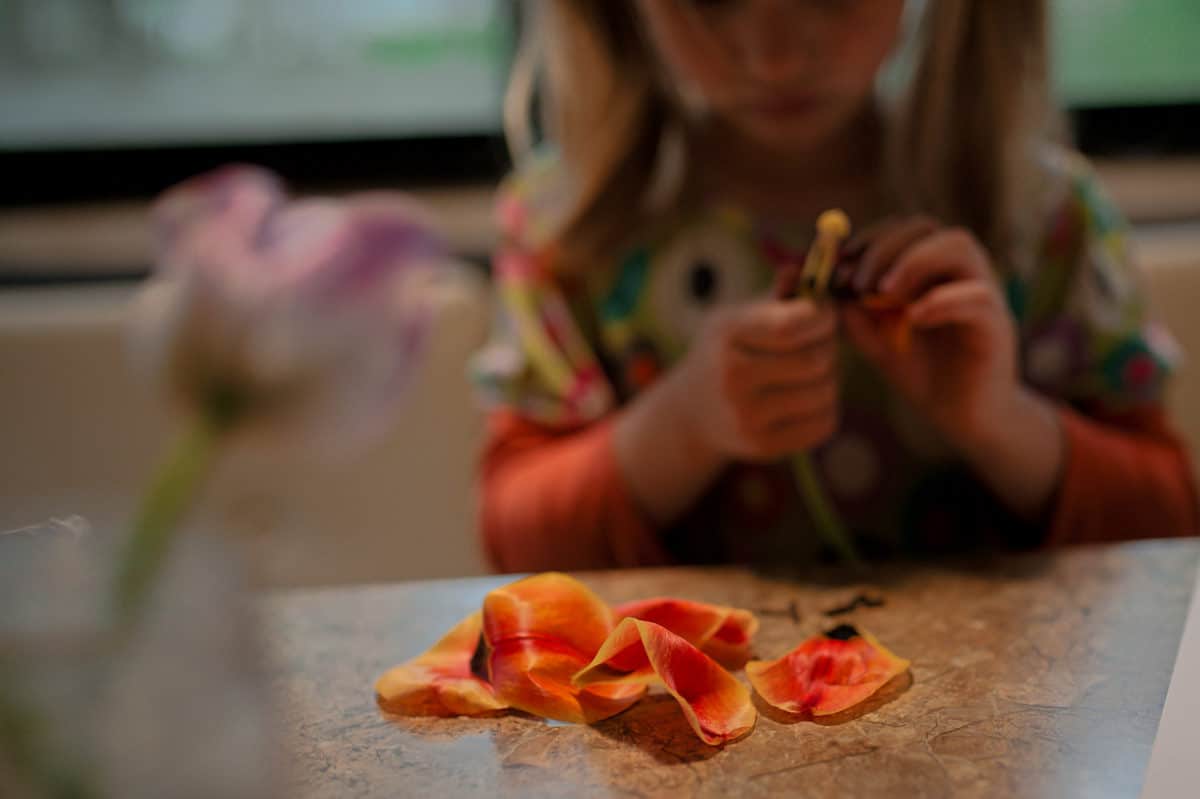
Planting bulbs with kids
Daffodils and tulips are both bulb plants, meaning they grow from a bulb deep in the earth, rather than a seed. The bulb stores up energy for the plant and goes dormant over the winter. Daffodil and tulip bulbs are best planted in the fall, so they can emerge as the daylight strengthens and the earth thaws at the end of winter. A healthy bulb will multiply year by year—if you plant a single daffodil bulb, within a few years you should have several!
My mother-in-law likes to tell how she once assigned her children the job of planting some daffodil bulbs in her new flower bed. They carefully inserted a single bulb in each hole, neatly spaced around the flower garden. The next year, she had single daffodils blooming everywhere! But after several years, she had the beautiful clusters she had once dreamed of.
To turn this into a long-term science project, plant some daffodil or tulip bulbs with your child this fall. You can find them at home improvement or garden centers in the fall months. You can also order them from seed catalogs or even see if a friend or neighbor has some to share. Then plant them about twice as deep as the bulb is tall (probably about 2-3 inches deep). In the spring, you’ll have your own daffodils and tulips to enjoy!
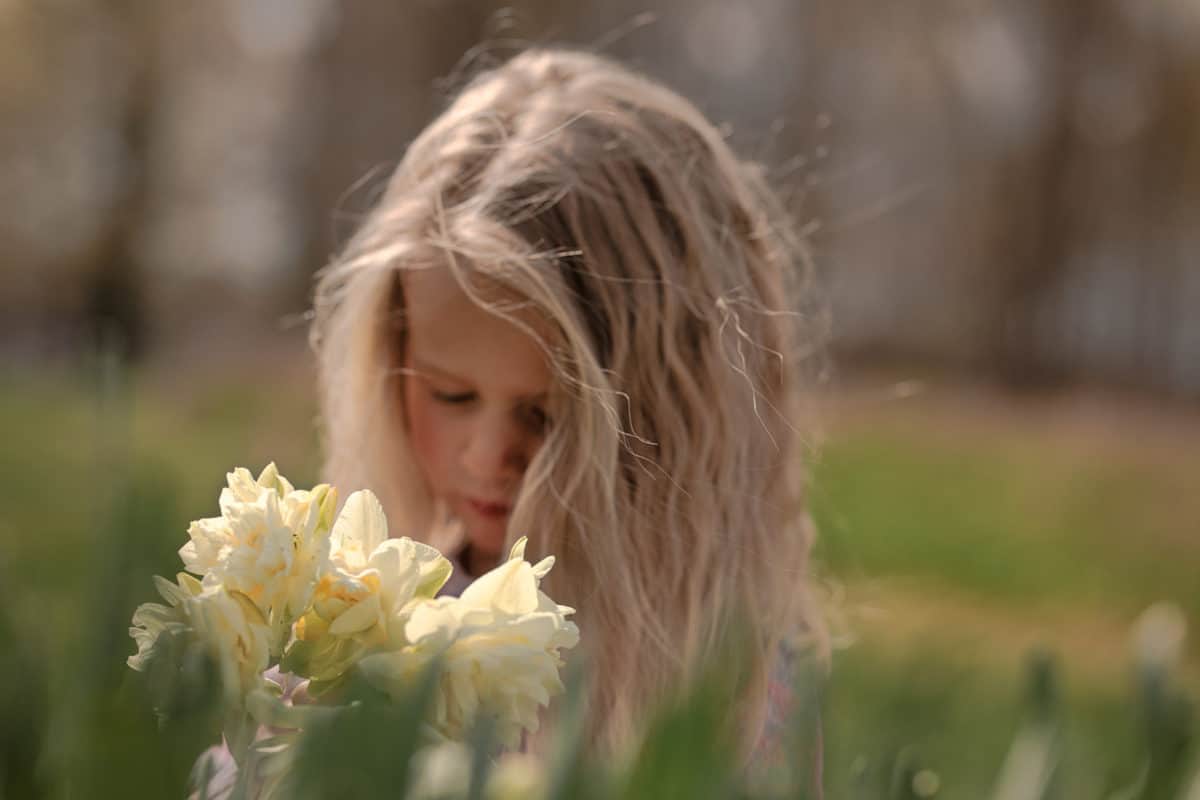
Tulips and daffodils in the cold
As cold-hardy plants, tulips and daffodils are able to survive chilly and even briefly freezing weather. If you live in an area where spring comes in fits and starts, like we do, you’ve probably seen daffodils with their heads bowed down with frost or even tulips dusted with snow. Amazingly, once the temperatures warm and the sun comes out, these hardy plants usually bounce back like nothing ever happened! Although temperatures below 25 may kill the blooms, the plants themselves will survive and bloom again the next year.
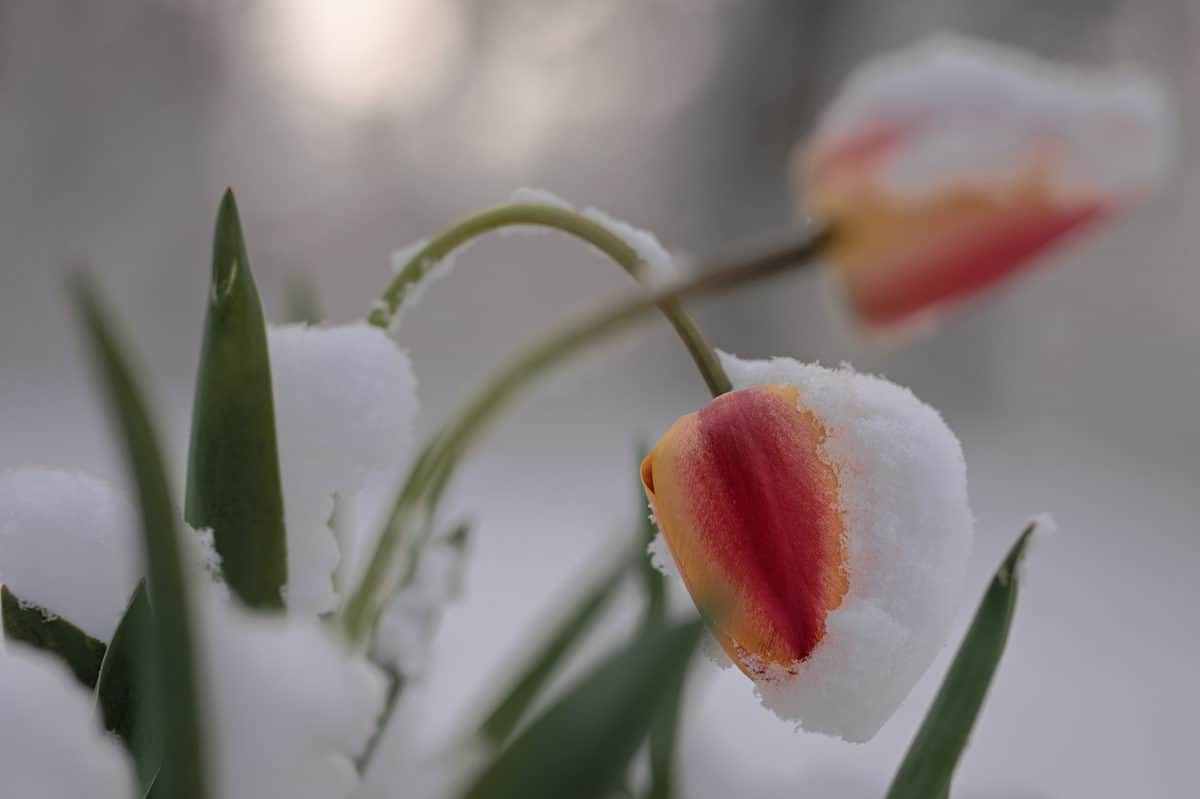
Making spring flower bouquets with kids
If you can’t get enough of these beautiful spring flowers, here are some more activities involving daffodils and tulips. First of all, make flower arrangements! This is one of the easiest and most rewarding hands-on activities you could ever let your kids do. It builds artistic skills and deeply satisfies the love of beauty that’s built into every one of us. If you don’t have spring flowers to pick, maybe a neighbor or friend has a yard full of them. Many times people won’t mind letting children pick a few for a bouquet.
Flower picking instructions for kids
This is a great time to help children learn how to pick flowers intentionally. Have them think through these questions as they select and pick their flowers:
- How many flowers do I need for this arrangement?
- Which colors and shapes will look good in my arrangement?
- What varieties/colors are there most of?
- Which flowers can I pick without leaving a hole in the beauty of the mother plant?
- Are there other flowers or greenery to pick from to complement the flowers in my arrangement?
Teach your kids how to pick the flowers carefully, carefully breaking off or cutting the stem. If you have a vase in mind, show them the vase and how much stem length they’ll need for their arrangement. (For some reason it’s hard for kids to learn to leave enough stem with the flower. They seem to have their eye on the flower and break the stem just past the flower. It always takes a while to teach them to cut the stem with their flower!) But most of all, just let them have fun putting together beautiful flowers to display inside your home. Or have them make a bouquet to give to a friend or neighbor!
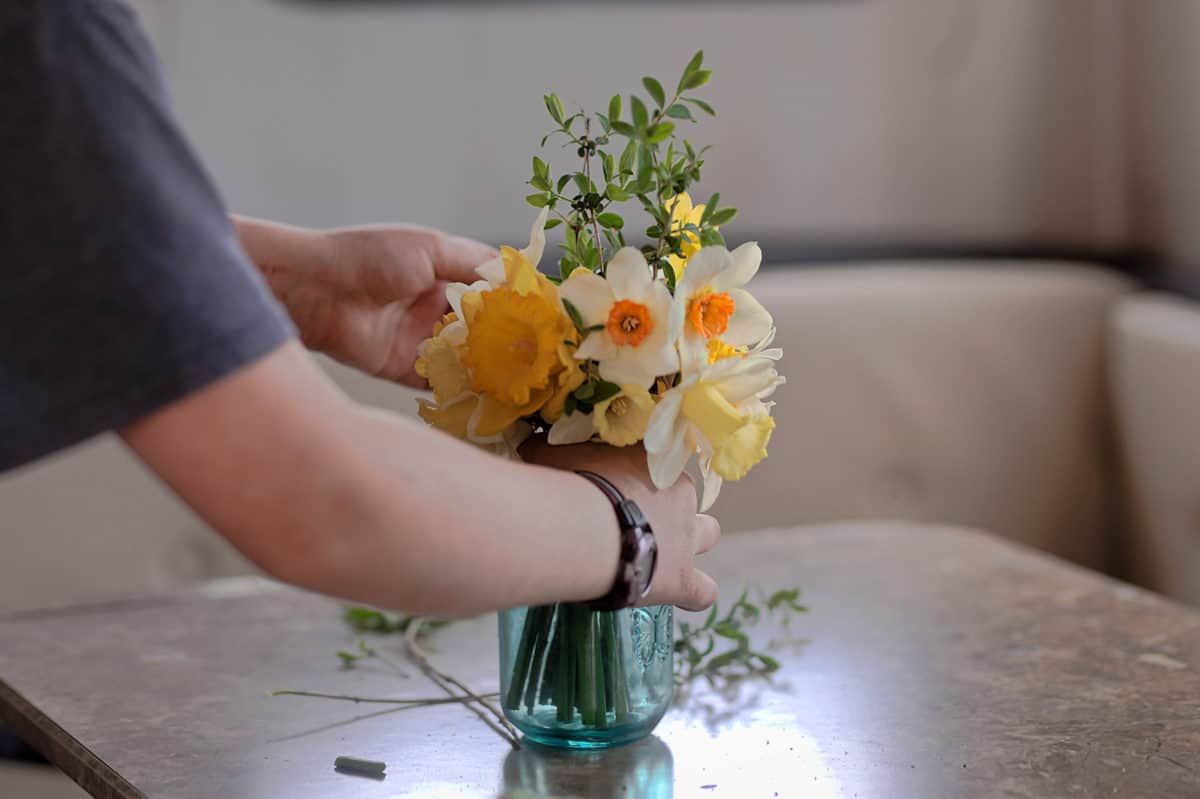
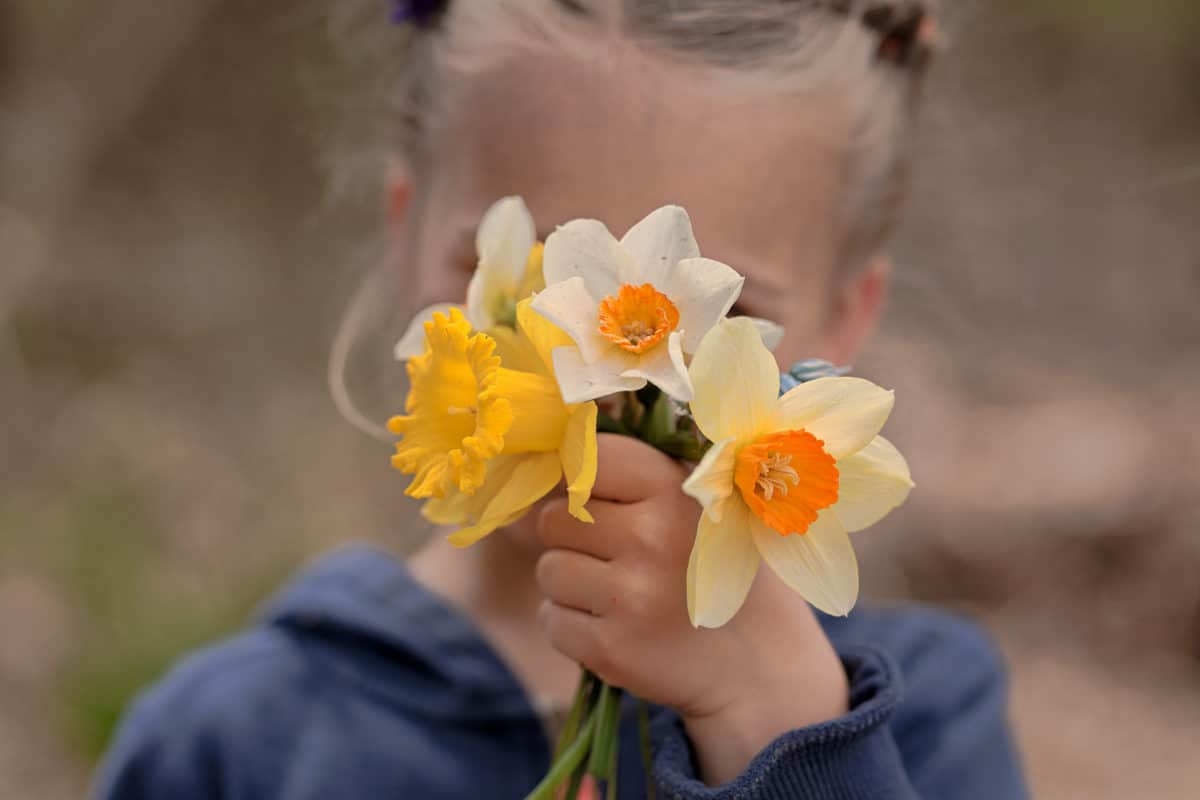
Dyeing daffodils with kids
Did you know daffodils can be turned different colors? This fun and simple experiment shows how their veins draw fluids up, through the stems, and out into the petals. Place a daffodil with white or light-colored petals into a glass of water and add food coloring. Better yet, try several daffodils in different colors of water. Set in a safe place and check back every day to watch the magic happen!
You should be able to see colors in the petals within 24 hours. My kids are fascinated with this–even our four-year-old loved checking in to see the colors changing. We’ve had issues with the flowers beginning to wilt and fade before the colors had time to make a really vibrant difference, though. So I’d recommend using the freshest blooms you can find and a strong food coloring solution for the best results.
In the meantime, since I failed to get a photo before our daffodils started getting all sad and wilted, my friend Ginny shared one of her amazing colored daffodils. Aren’t those lacy-colored veins just gorgeous?
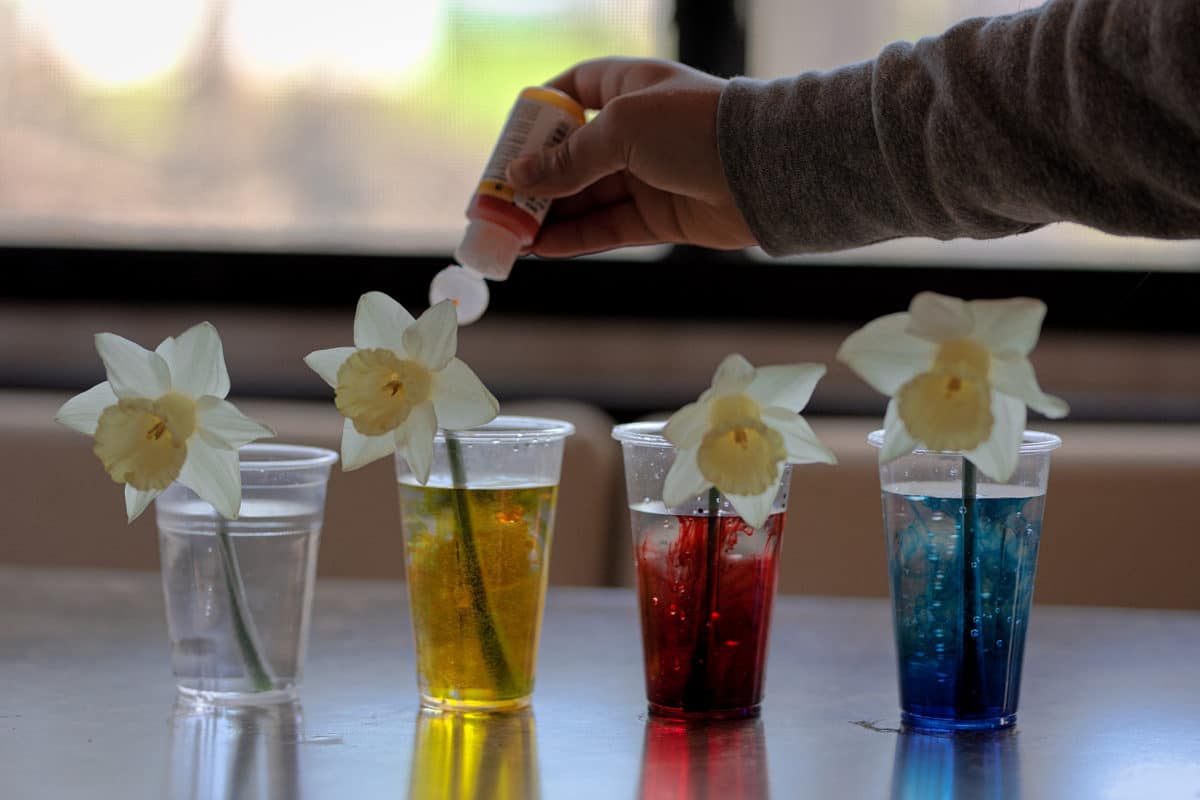
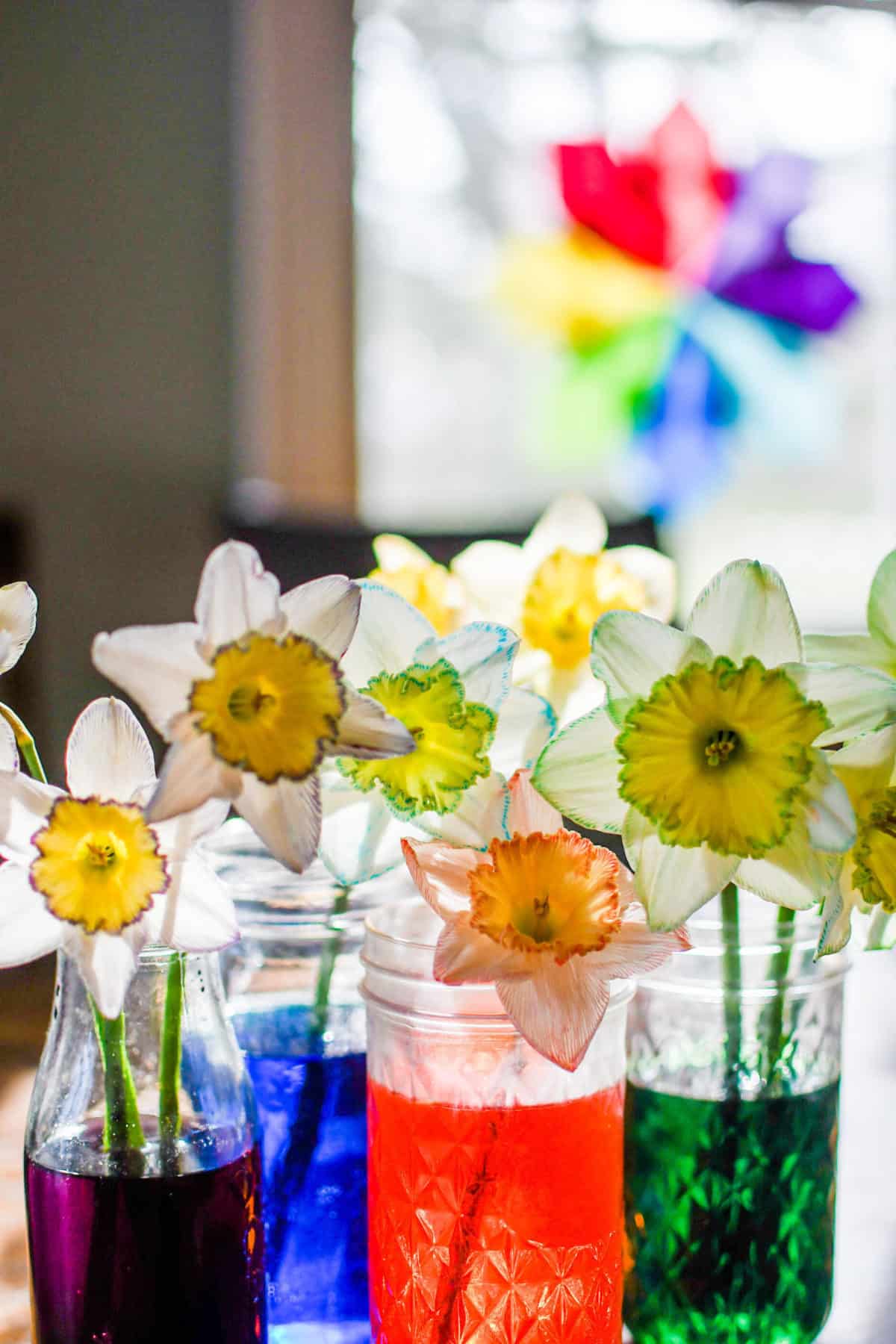
Photo credit Ginny Yurich @1000hoursoutside
Spring flower fun for kids
Whether you dissect them, dye them, plant them, or just pick some for a bouquet, daffodils and tulips are some of spring’s greatest delights. So be sure to get out and find some to enjoy with your kids!
Have you ever dissected tulips or daffodils with your kids?

About the author
Leslie is an Ohio farm girl and chaser of light, children, and sometimes chickens. She’s a lover of Jesus, wife to her high school sweetheart, and a homeschooling mom of four wild rascals who love the great outdoors as much as she does. As a family, they love hiking, camping, fishing, and just about any outdoor activity. She and her husband are just beginning the process of building a homestead from the ground up, doing most of the work themselves. Leslie has a lifelong obsession with writing and capturing everyday life from behind the lens. Follow along with their homesteading, homeschooling, and everyday adventures on her Instagram account.
You can find more from Leslie in the following locations:
Instagram: @c_l_allofus
Leslie’s RWMC posts: Leslie Alvis








Great photos. The ads though! They’re out of control, keep popping out & covering the photos. Ruins site.